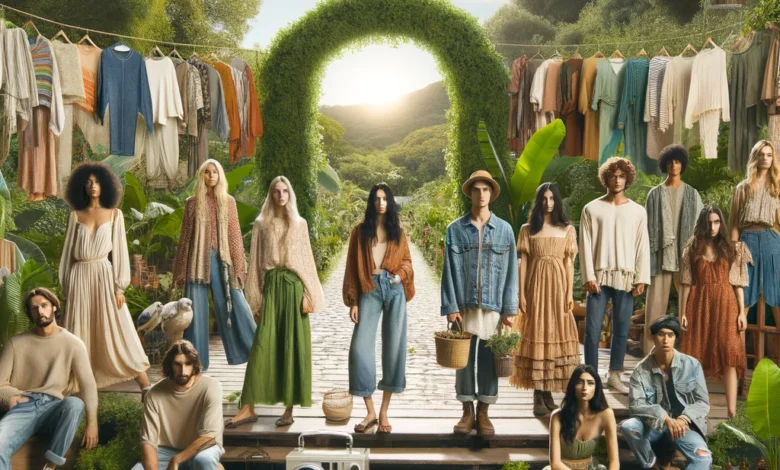Sustainable Fashion Trends for 2024

Introduction
Sustainable fashion has rapidly transitioned from a niche interest to a mainstream movement, and as we head into 2024, its influence only continues to grow. With climate change, environmental concerns, and ethical considerations becoming more prevalent in public discourse, sustainable fashion is no longer just a trend—it’s a necessity. This article delves into the key sustainable fashion trends shaping 2024, offering insights into how individuals and communities can embrace a more eco-friendly wardrobe without compromising on style.
The Rise of Conscious Consumerism
In recent years, there has been a significant shift in how people view their consumption habits, especially in the fashion industry. The rise of conscious consumerism has led to a greater awareness of the environmental and ethical impacts of our clothing choices. More than ever, consumers are asking questions about where their clothes come from, how they are made, and the true cost of their production.
Social media has played a pivotal role in this transformation. Platforms like Instagram and TikTok have become hubs for spreading awareness about sustainable practices, with influencers and activists educating their followers on the importance of making mindful fashion choices. This cultural shift towards sustainability is also fueled by increased education and awareness campaigns that highlight the dire consequences of fast fashion, from environmental degradation to human rights violations.
Key Sustainable Fashion Trends for 2024
2024 is set to be a landmark year for sustainable fashion, with several key trends leading the way. Let’s explore these trends in detail:
Eco-Friendly Fabrics
One of the most significant developments in sustainable fashion is the use of eco-friendly fabrics. Designers and consumers alike are moving away from synthetic materials like polyester, which contribute to microplastic pollution, and are instead opting for natural, biodegradable alternatives.
- Organic Cotton: Organic cotton remains a staple in sustainable fashion. Unlike conventional cotton, which is notorious for its heavy pesticide use and water consumption, organic cotton is grown without harmful chemicals and requires less water, making it a much more environmentally friendly option.
- Hemp and Linen: These ancient fibers are making a comeback in 2024. Hemp is incredibly durable and requires minimal resources to grow, while linen, made from flax, is highly breathable and biodegradable. Both materials are celebrated for their low environmental impact and versatility.
- Bamboo Textiles: Bamboo is another eco-friendly material gaining popularity. It grows rapidly without the need for pesticides and can be transformed into a soft, breathable fabric. However, it’s important to ensure that the bamboo processing methods are environmentally responsible, as some can involve harmful chemicals.
- Recycled and Upcycled Materials: Recycling old garments and using upcycled materials is a key trend in sustainable fashion. Designers are getting creative with waste, transforming discarded textiles into high-fashion pieces. This not only reduces waste but also gives new life to materials that would otherwise end up in landfills.
Slow Fashion Movement
The slow fashion movement is gaining momentum as an antidote to the fast fashion industry, which is often criticized for its negative environmental and ethical impacts. Slow fashion encourages consumers to buy less, choose well, and make it last.
- The Concept of Slow Fashion: Slow fashion is all about quality over quantity. It emphasizes timeless designs, durable materials, and ethical production methods. By choosing well-made garments that can be worn for years, consumers can significantly reduce their fashion footprint.
- Benefits Over Fast Fashion: Unlike fast fashion, which relies on mass production and disposable trends, slow fashion promotes a more thoughtful and deliberate approach to style. It fosters a connection between the consumer and their clothing, encouraging them to appreciate the craftsmanship and care that goes into each piece.
- How to Embrace Slow Fashion in Daily Life: Adopting a slow fashion mindset starts with changing your shopping habits. Look for quality pieces that you truly love and that will stand the test of time. Invest in versatile items that can be styled in multiple ways, and don’t be afraid to repair or alter your clothes to extend their lifespan.
Minimalist Wardrobes
Minimalism in fashion is more than just a trend—it’s a lifestyle. The minimalist wardrobe concept aligns perfectly with sustainable fashion principles, focusing on simplicity, intentionality, and longevity.
- Capsule Wardrobes: A capsule wardrobe is a curated collection of essential items that can be mixed and matched to create a variety of outfits. This approach encourages mindful purchasing and reduces the need for excess clothing. Capsule wardrobes are particularly popular among those looking to simplify their lives and reduce their environmental impact.
- Importance of Quality Over Quantity: In a minimalist wardrobe, every piece matters. The focus is on high-quality, versatile items that are durable and timeless. By choosing fewer, better-made clothes, you can minimize waste and ensure that your wardrobe remains functional and stylish for years to come.
- Tips for Building a Minimalist Wardrobe: Start by decluttering your closet and identifying the pieces you wear most often. Invest in classic items that fit well and can be worn in multiple ways. Stick to a neutral color palette that is easy to mix and match, and prioritize quality over quantity when making new purchases.
Vintage and Second-Hand Clothing
Thrift shopping and vintage clothing have seen a resurgence in popularity, driven by the desire for unique, sustainable fashion choices. Buying second-hand is one of the most effective ways to reduce the environmental impact of your wardrobe.
- Rise of Thrift Shopping: Thrift shopping is not only budget-friendly but also eco-friendly. By purchasing second-hand clothing, you extend the life of garments and reduce the demand for new production, which in turn lowers the overall carbon footprint of the fashion industry.
- Advantages of Vintage Clothing: Vintage clothing offers a unique blend of history, craftsmanship, and style. These pieces are often made with higher quality materials and construction methods than contemporary fast fashion items. Wearing vintage allows you to stand out with one-of-a-kind pieces while supporting sustainable fashion practices.
- Styling Tips for Second-Hand Finds: When shopping for vintage or second-hand clothing, keep an open mind and be willing to experiment. Look for classic silhouettes that can be easily updated with modern accessories. Don’t be afraid to mix and match eras to create a look that is uniquely yours.
Circular Fashion Economy
The circular fashion economy is a transformative approach to fashion that focuses on designing out waste and keeping products and materials in use for as long as possible.
- Understanding Circular Fashion: Circular fashion involves creating clothes that are designed to be reused, remade, or recycled. This approach challenges the traditional linear fashion model of “take, make, dispose” and aims to create a closed-loop system where garments have a longer, more sustainable life cycle.
- Role of Recycling and Upcycling: Recycling and upcycling are key components of the circular fashion economy. Recycling involves breaking down old textiles to create new materials, while upcycling involves creatively reimagining old garments into new designs. Both practices reduce waste and extend the life of clothing.
- Innovations in Circular Fashion: Innovations such as biodegradable fabrics, modular clothing, and take-back programs are driving the circular fashion movement forward. These developments make it easier for consumers to participate in sustainable practices and for the industry to reduce its environmental impact.
Sustainable Fashion Innovations
Innovation is at the heart of the sustainable fashion movement, with new technologies and materials paving the way for a more eco-friendly future.
Biodegradable Clothing
Biodegradable clothing represents the cutting edge of sustainable fashion, offering a solution to the growing problem of textile waste.
- Materials and Innovations: Biodegradable clothing is made from natural fibers like organic cotton, hemp, and wool, which break down naturally over time without leaving harmful residues. Some brands are even experimenting with innovative materials like mushroom leather and seaweed-based fabrics, which decompose quickly and safely.
- Future Potential: As the demand for sustainable fashion grows, biodegradable clothing has the potential to become a mainstream choice. Continued research and development in this area could lead to even more eco-friendly options, helping to reduce the fashion industry’s impact on the environment.
Tech-Integrated Sustainability
The integration of technology into fashion is opening up new possibilities for sustainability, from smart fabrics to AI-driven production processes.
- Wearable Technology for Sustainable Living: Wearable technology is not only about fitness trackers and smartwatches—it’s also making its way into sustainable fashion. Innovations like clothing that monitors environmental conditions or adjusts to temperature changes can reduce the need for multiple garments, thereby lowering consumption.
- AI in Fashion Production: Artificial intelligence is being used to optimize fashion production, reducing waste and improving efficiency. AI can help predict trends, manage inventory, and even design garments, making the fashion industry more responsive and less wasteful.
Ethical Supply Chains
Transparency and ethics in supply chains are crucial for the success of sustainable fashion. Consumers are increasingly demanding to know where and how their clothes are made.
- Importance of Transparent Supply Chains: A transparent supply chain ensures that every step of the production process is ethical, from the sourcing of raw materials to the manufacturing and distribution of finished products. This transparency builds trust with consumers and ensures that fashion brands are held accountable for their practices.
- Innovations in Ethical Production: Innovations like blockchain technology are making it easier to track and verify the origins of materials and the conditions in which they are produced. This helps ensure that garments are made in fair and humane conditions, supporting workers and minimizing the environmental impact.
Global Influence on Sustainable Fashion
Sustainable fashion is not just a Western trend—it’s a global movement influenced by diverse cultures and regional practices.
Cultural Influences
Indigenous cultures and traditional practices have long embraced sustainability, offering valuable lessons for the modern fashion industry.
- Indigenous Practices in Sustainable Fashion: Indigenous communities have a deep understanding of sustainable living, often using natural materials and techniques passed down through generations. These practices are being rediscovered and celebrated in the sustainable fashion movement, providing inspiration for more ethical and eco-friendly design.
- Global Trends Shaping Sustainability: From Scandinavia’s minimalist design principles to Japan’s focus on quality craftsmanship, global trends are shaping the future of sustainable fashion. These diverse influences contribute to a richer, more inclusive approach to sustainability.
Regional Sustainability Initiatives
Different regions are leading the charge in sustainable fashion, each with its unique approach and focus.
- Europe’s Role in Fashion Sustainability: Europe has been at the forefront of sustainable fashion, with many countries implementing strict regulations on textile production and waste. Initiatives like the European Green Deal are driving innovation and encouraging the fashion industry to adopt more sustainable practices.
- Emerging Markets and Sustainable Practices: Emerging markets in Asia, Africa, and Latin America are also making strides in sustainable fashion. These regions are developing new, innovative ways to produce and consume fashion that align with their cultural values and environmental challenges.
Challenges in Sustainable Fashion
While the sustainable fashion movement is gaining momentum, it faces several significant challenges that must be addressed to achieve widespread adoption.
Economic Barriers
Affordability and accessibility remain major hurdles for sustainable fashion, particularly for lower-income consumers.
- Affordability and Accessibility: Sustainable fashion often comes with a higher price tag, making it less accessible to a broader audience. This is due to the higher costs associated with ethical production and eco-friendly materials. Finding ways to make sustainable fashion more affordable is essential for its widespread adoption.
- Solutions to Economic Challenges: Solutions like fashion rental services, clothing swaps, and second-hand shopping can help make sustainable fashion more accessible. Additionally, as demand for sustainable fashion increases, economies of scale may help bring down prices.
Environmental Impact
Measuring and mitigating the environmental impact of fashion remains a complex challenge, even for sustainable practices.
- Measuring the True Environmental Cost: Even sustainable fashion has an environmental impact, from the resources used to grow natural fibers to the energy required for production. It’s important to measure these impacts accurately and work towards minimizing them wherever possible.
- Strategies to Reduce Fashion’s Footprint: Strategies like reducing water use, switching to renewable energy, and developing closed-loop production systems can help reduce the environmental impact of fashion. Consumers can also play a role by choosing low-impact garments and supporting brands that prioritize sustainability.
Consumer Behavior
Changing consumer behavior is one of the biggest challenges in the transition to sustainable fashion.
- Challenges in Changing Consumer Habits: Many consumers are accustomed to the convenience and affordability of fast fashion, making it difficult to shift to more sustainable habits. Education and awareness campaigns are crucial for helping consumers understand the benefits of sustainable fashion and encouraging them to make more mindful choices.
- Role of Incentives and Policies: Government policies and incentives can play a significant role in promoting sustainable fashion. Tax breaks for sustainable brands, subsidies for eco-friendly materials, and regulations on waste and emissions can help drive the industry towards sustainability.
The Future of Sustainable Fashion
Looking ahead, the future of sustainable fashion is full of exciting possibilities. As technology advances and consumer demand for sustainability grows, the fashion industry is poised for significant transformation.
Predictions for the Next Decade
The next decade will likely see even greater innovation in sustainable fashion, with new materials, technologies, and business models emerging.
- What’s Next in Sustainable Fashion?: Expect to see more biodegradable materials, tech-integrated clothing, and circular fashion models becoming mainstream. The focus will also shift towards creating garments that are not only sustainable but also regenerative, contributing positively to the environment.
- Potential Game-Changing Innovations: Innovations like 3D printing, biofabrication, and smart textiles could revolutionize the way we produce and consume fashion. These technologies have the potential to drastically reduce waste, lower costs, and create more personalized, sustainable fashion experiences.
The Role of Young Designers
Young designers are at the forefront of the sustainable fashion movement, bringing fresh ideas and innovative approaches to the industry.
- Emerging Designers Leading the Change: Many of the most exciting developments in sustainable fashion are coming from young, emerging designers who are passionate about creating positive change. These designers are challenging traditional fashion norms and pushing the boundaries of what is possible with sustainable materials and practices.
- How the Next Generation is Shaping Sustainability: The next generation of designers is not only focused on sustainability in fashion but also on broader issues of social and environmental justice. Their work is helping to redefine what it means to be a fashion designer in the 21st century, emphasizing ethics, responsibility, and innovation.
How to Participate in the Sustainable Fashion Movement
Everyone can play a part in the sustainable fashion movement, whether through individual choices, community involvement, or supporting broader initiatives.
Practical Steps for Consumers
Consumers have the power to drive change in the fashion industry by making more sustainable choices.
- How to Make Sustainable Choices: Start by choosing quality over quantity and investing in timeless pieces that will last. Look for eco-friendly materials and ethical production practices, and consider the entire lifecycle of your clothing—from purchase to disposal.
- Supporting Ethical Brands Without Overspending: You don’t need to break the bank to support sustainable fashion. Thrift shopping, clothing swaps, and DIY alterations are all budget-friendly ways to make sustainable choices. Additionally, many sustainable brands are now offering more affordable options to cater to a wider audience.
Community Involvement
Getting involved in your community can amplify your impact and help spread the message of sustainable fashion.
- Participating in Clothing Swaps and Drives: Clothing swaps are a fun and sustainable way to refresh your wardrobe without buying new clothes. Participating in or organizing a swap in your community can help reduce waste and encourage others to think more sustainably about fashion.
- Educating Others About Sustainable Fashion: Sharing your knowledge and passion for sustainable fashion with others can have a ripple effect. Whether through social media, local workshops, or simply talking to friends and family, you can help raise awareness and inspire more people to make eco-friendly fashion choices.
Conclusion
Sustainable fashion is not just a passing trend—it’s the future of the fashion industry. By embracing eco-friendly fabrics, slow fashion principles, minimalist wardrobes, and innovations in circular fashion, we can all contribute to a more sustainable world. The challenges are significant, but with the right mindset and collective action, we can make sustainable fashion the norm rather than the exception. So, let’s step into 2024 with a commitment to making our wardrobes as sustainable as they are stylish.
FAQs on Sustainable Fashion Trends
- What is the most sustainable fabric?
- Organic cotton, hemp, and bamboo are among the most sustainable fabrics, offering low environmental impact and biodegradability.
- How can I start building a sustainable wardrobe?
- Begin by decluttering your closet, investing in quality pieces, and opting for eco-friendly materials. Embrace minimalist and slow fashion principles to guide your choices.
- Is sustainable fashion affordable?
- While some sustainable fashion items can be pricey, options like thrift shopping, clothing swaps, and buying from emerging eco-friendly brands can make it more accessible.
- How does slow fashion differ from fast fashion?
- Slow fashion focuses on quality, ethical production, and longevity, while fast fashion emphasizes rapid production of cheap, trendy items often with little regard for environmental or ethical concerns.
- What are the environmental benefits of sustainable fashion?
- Sustainable fashion reduces waste, lowers carbon emissions, and minimizes the use of harmful chemicals, contributing to a healthier planet.


